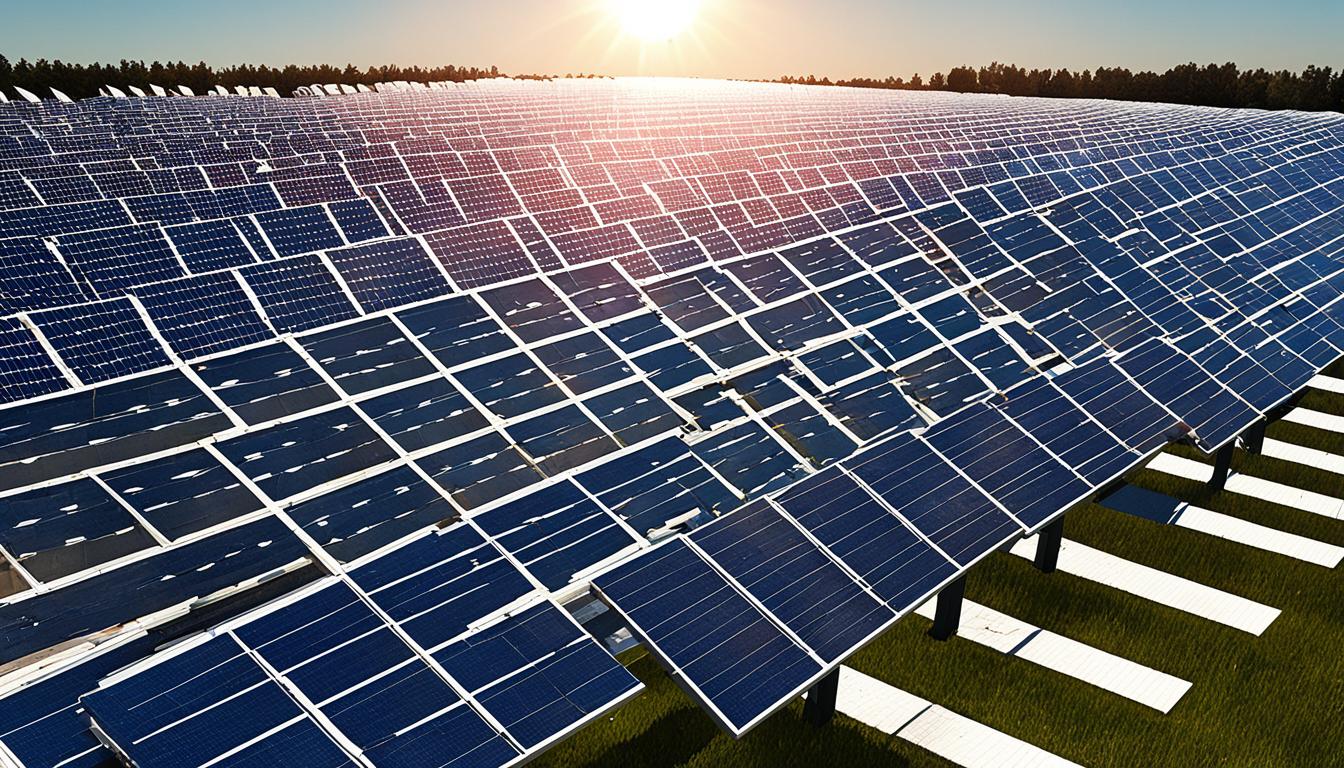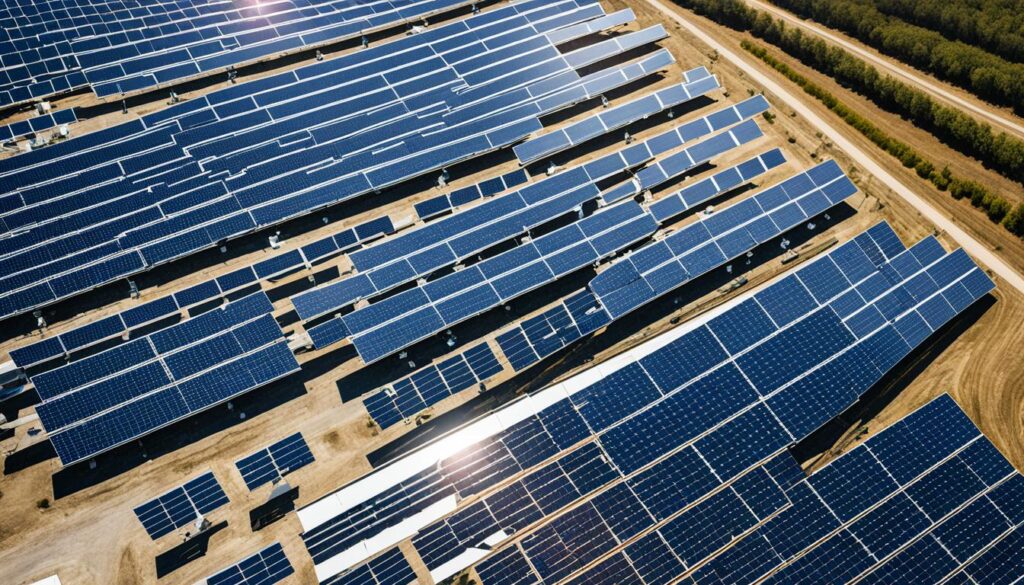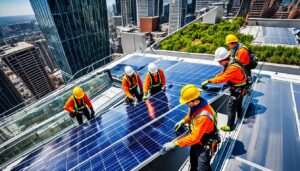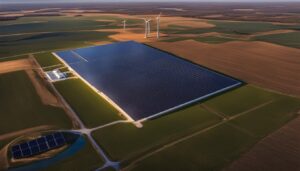
Solar power plants are vital in our transition to renewable energy sources. To optimize energy production and pave the way for a sustainable future, understanding the factors that impact the efficiency of these plants is crucial.
The efficiency of solar power plants is influenced by various factors, including geographic location, weather conditions, technology used, and maintenance practices. The geographic location plays a significant role, as regions with high solar radiation and longer sunny days tend to have higher energy output. Weather conditions, such as cloud cover and temperature, also influence the performance of solar panels.
When it comes to technology, advancements in solar cell designs and materials can significantly improve the conversion efficiency and overall energy production of solar power plants. Additionally, proper maintenance practices, including regular cleaning and inspection of solar panels, ensure optimal performance and efficiency.
By considering these factors and implementing the right strategies, solar power plants can achieve higher efficiency and contribute significantly to clean energy production. So, let’s dive deeper into the factors affecting solar power plant efficiency and explore ways to optimize energy production.
Key Takeaways:
- The efficiency of solar power plants is influenced by factors such as geographic location, weather conditions, technology, and maintenance practices.
- Solar panel orientation and tilt angle play a crucial role in optimizing energy absorption.
- Tracking systems that follow the movement of the sun can enhance energy production.
- Advancements in solar cell technology contribute to higher conversion efficiency.
- Proper maintenance practices, including regular cleaning and inspection, ensure optimal performance.
Factors Affecting Solar Power Plant Efficiency
The efficiency of a solar power plant is influenced by several key factors. Firstly, the geographic location plays a crucial role in determining the energy output. Regions with high solar radiation and longer sunny days tend to have higher energy production. This is due to the availability of ample sunlight for the solar panels to convert into electricity. Areas closer to the equator, for example, receive more direct sunlight throughout the year and therefore have the potential for greater efficiency.
Weather conditions also impact the efficiency of solar panels. Cloud cover can reduce the amount of sunlight reaching the panels, affecting their ability to generate electricity. Similarly, extreme temperatures can affect the performance and lifespan of solar cells. It is essential to consider these weather-related factors when designing and operating solar power plants to ensure optimal efficiency.
“The geographic location of a solar power plant, as well as the prevailing weather conditions, are significant factors that can impact its overall efficiency and energy production.” – Solar Efficiency Expert
The technology used in a solar power plant is another critical factor influencing its efficiency. Advances in solar cell designs and materials have led to increased conversion efficiency, allowing more sunlight to be converted into electricity. Innovations such as multi-junction solar cells and perovskite solar cells have shown promising results in improving overall energy production. The choice of technology can significantly impact the efficiency and output of a solar power plant.
Maintenance practices also play a vital role in ensuring optimal efficiency. Regular cleaning and inspection of solar panels are essential to remove dust, dirt, and other debris that can reduce the panel’s ability to absorb sunlight. Additionally, proactive maintenance practices that involve identifying and addressing any issues or faults promptly can help prevent potential efficiency losses and ensure consistent energy production.
To summarize, several factors affect the efficiency of solar power plants. The geographic location, weather conditions, technology used, and maintenance practices all contribute to the overall performance and energy output. By considering these factors and implementing effective strategies, solar power plant operators can enhance their efficiency, maximize energy production, and contribute to a more sustainable future.

| Factors Affecting Solar Power Plant Efficiency | Description |
|---|---|
| Geographic Location | Areas with high solar radiation and longer sunny days tend to have higher energy output. |
| Weather Conditions | Cloud cover and extreme temperatures can impact the efficiency of solar panels. |
| Technology | Advanced solar cell designs and materials can improve conversion efficiency. |
| Maintenance Practices | Regular cleaning and inspection of solar panels ensure optimal performance. |
Optimizing Energy Production in Solar Power Plants
To maximize the energy production of solar power plants, it is crucial to optimize various aspects. One of the key factors that influence energy capture is solar panel orientation. By orienting the panels towards the south (in the Northern Hemisphere) or north (in the Southern Hemisphere), solar power plants can optimize energy absorption. This strategic alignment ensures that the panels receive maximum sunlight exposure throughout the day.
Another important consideration is the tilt angle of the solar panels. The tilt angle should be adjusted based on the latitude of the location to maximize energy output. By positioning the panels at the optimal tilt angle, they can effectively capture sunlight at different times of the day, maximizing energy production. This adjustment takes into account the angle at which the solar panels receive the most direct sunlight.
Tracking systems also play a significant role in optimizing energy production. These systems automatically adjust the orientation of solar panels to ensure they are always facing the sun directly. By tracking the movement of the sun throughout the day, solar power plants can optimize energy capture and enhance overall efficiency. This continuous adjustment ensures that the panels are aligned for maximum exposure to sunlight.
Implementing these optimization techniques allows solar power plants to achieve higher energy production and improve their overall efficiency. By ensuring proper solar panel orientation, adjusting the tilt angle, and utilizing tracking systems, these plants can harness the full potential of solar energy and contribute to a cleaner and more sustainable future.
![]()
| Optimization Technique | Benefits |
|---|---|
| Solar Panel Orientation | – Maximizes energy absorption – Enhances overall energy output – Optimizes sunlight exposure |
| Tilt Angle Adjustment | – Maximizes energy capture throughout the day – Increases energy production |
| Tracking Systems | – Ensures panels always face the sun directly – Optimizes energy capture – Improves overall efficiency |
Conclusion
Maximizing the efficiency of solar power plants is crucial for the advancement of renewable energy and the goal of a sustainable future. By carefully considering factors such as geographic location, weather conditions, technology, and maintenance practices, solar power plant operators can optimize their energy production.
Factors like solar panel orientation, tilt angle, and tracking systems also play a significant role in maximizing energy output. Properly orienting the solar panels towards the optimal direction and adjusting their tilt angle according to the location’s latitude can significantly enhance energy absorption. Moreover, implementing tracking systems that follow the sun’s movement throughout the day ensures that the panels are always facing the sun directly, further increasing energy production.
As advancements in solar cell technology continue, the efficiency of solar power plants is improving. New designs and materials contribute to higher conversion rates, allowing for greater energy output. By focusing on these key aspects, solar power plants can make substantial contributions to the generation of clean and sustainable energy, helping to reduce our dependence on fossil fuels and mitigate the impacts of climate change.
FAQ
What factors influence the efficiency of a solar power plant?
The efficiency of a solar power plant is influenced by factors such as geographic location, weather conditions, technology used, and maintenance practices.
How does the geographic location impact the efficiency of a solar power plant?
Regions with high solar radiation and longer sunny days tend to have higher energy output.
What role does weather conditions play in solar power plant efficiency?
Weather conditions such as cloud cover and temperature can impact the efficiency of solar panels.
What is the significance of technology used in solar power plants?
Advanced solar cell designs and materials can improve conversion efficiency and overall energy production.
How important is maintenance in optimizing solar power plant efficiency?
Proper maintenance practices, including regular cleaning and inspection of solar panels, can ensure optimal performance.
How can solar panel orientation be optimized to maximize energy production?
Orienting the panels towards the south (in the Northern Hemisphere) or north (in the Southern Hemisphere) can optimize energy absorption.
What is the ideal tilt angle for solar panels?
The tilt angle of the solar panels should be adjusted based on the latitude of the location to maximize energy output.
How can tracking systems enhance energy production in solar power plants?
Tracking systems that follow the movement of the sun throughout the day can adjust the orientation of solar panels to ensure they are always facing the sun directly.








